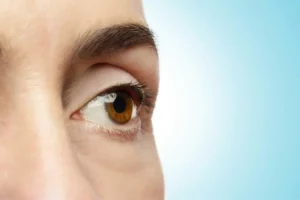Home » What are Implantable Collamer Lens
How Safe is SMILE Laser Eye Surgery? A Comprehensive Look at the Safety and Efficacy of This Vision Correction Procedure

Overview
As the number of people experiencing vision problems continues to rise, refractive surgery has become an increasingly popular solution for individuals who want to reduce their dependence on glasses and contact lenses. One such vision correction surgery that has gained traction among both ophthalmologists and patients in recent years is SMILE (Small Incision Lenticule Extraction). This article aims to provide a balanced and comprehensive understanding of the safety, risks, and benefits of SMILE eye surgery, comparing it to other procedures like LASIK and PRK.
Table of Contents
SMILE Eye Surgery: The Basics

SMILE is a minimally invasive, FDA-approved laser vision correction procedure that corrects refractive errors like nearsightedness (myopia), farsightedness (hyperopia), and astigmatism. Developed by the German company ZEISS, SMILE utilizes a femtosecond laser to create a small incision in the cornea and remove a lenticule (a thin disc of corneal tissue) to reshape the cornea and improve vision. The procedure’s primary advantages include a faster recovery time, reduced dry eye symptoms, and preserved corneal nerves.
Comparing SMILE to LASIK and PRK
LASIK (Laser-Assisted In Situ Keratomileusis) and PRK (Photorefractive Keratectomy) are two other popular laser vision correction procedures. While LASIK involves creating a corneal flap and using an excimer laser to reshape the underlying corneal tissue, PRK involves removing the outer layer of the cornea (the epithelium) and using the excimer laser directly on the corneal surface. Both procedures have been successfully used to treat refractive errors for decades.

SMILE - What to Expect
You should talk with your ophthalmologist about what to expect from this surgery. They’ll tell you not to expect perfect vision without glasses or contact lenses. It’s possible your vision will improve to that point, but it isn’t certain. It’s important to have realistic expectations.
After SMILE surgery, you’ll probably be able to perform most tasks without corrective glasses. Your vision will certainly be better. But you may still have to use glasses for some activities, like driving at night or reading.
Almost all people who undergo SMILE surgery achieve visual acuity of 20/40 without glasses or contact lenses. About 88% (7 out of 8) achieve 20/20 vision without glasses or contact lenses.
Advantages of SMILE Laser Eye Surgery

Less Invasive Procedure
One of the chief advantages of SMILE is its minimally invasive nature. Unlike LASIK, which requires creating a larger corneal flap, SMILE only involves a small incision of about 2-4mm. This reduced manipulation of the cornea lowers the risk of complications such as dry eye syndrome and epithelial ingrowth, a condition where cells grow under the flap created during LASIK.
Less Risk of Corneal Ectasia
Corneal ectasia, a potentially serious complication involving thinning and bulging of the cornea, is less likely with SMILE than with LASIK. As SMILE leaves more of the cornea untouched, it maintains more biomechanical stability, reducing the risk of this condition.
Reduced Dry Eye Syndrome
Postoperative dry eye is a frequent complaint following LASIK, as the procedure can disrupt the corneal nerves responsible for tear production. Due to the smaller incision in SMILE, there’s less disruption of corneal nerves, thus reducing the incidence and severity of dry eye syndrome postoperatively.
For NYC Patients
Safety of SMILE Eye Surgery
Clinical studies and real-world experience suggest that SMILE laser eye surgery is a safe and effective treatment for vision problems. The procedure boasts a high success rate, with over 99% of SMILE patients achieving 20/40 vision or better, and more than 90% achieving 20/20 vision or better. Additionally, SMILE has been shown to be safer than LASIK in certain aspects, such as lower risk of corneal ectasia and reduced dry eye symptoms.
Possible Side Effects and Risks of SMILE
As with any surgical procedure, SMILE carries some risks and potential side effects. These may include:
1. Under-correction or overcorrection:
Some patients may experience incomplete correction of their refractive error or overcorrection. This occurs when the SMILE procedure doesn’t fully correct the refractive error, meaning the eye is still somewhat nearsighted even after the surgery. This could be due to the individual’s unique healing response, which may cause the cornea to regress slightly towards its original shape, hence diminishing the effect of the surgery. Patients experiencing undercorrection might still require glasses or contact lenses for certain tasks, though their dependency on them should be significantly less than before surgery. to the need for follow-up treatments or enhancements.
2. Infection:
Although rare, infection can occur following SMILE surgery. Patients should use prescribed antibiotic eye drops and follow their eye doctor’s post-operative care instructions to minimize this risk.
Despite these precautions, if you suspect an infection – for example, if your eye becomes increasingly red, painful, or your vision declines, you should contact your ophthalmologist immediately. Early detection and treatment of infections are critical to prevent potential complications and safeguard your vision.
3. Dry eye symptoms:
While SMILE is associated with fewer dry eye symptoms than LASIK, some patients may still experience temporary dryness, which can be managed with artificial tears and other eye drops.
4. Night vision problems:
Some patients may experience halos, starbursts, or glare around lights at night. These symptoms typically improve over time as the eye heals.
5. Corneal complications:
Rarely, complications related to the corneal incision or lenticule removal may occur. These may include epithelial ingrowth or corneal haze.
6. Accessibility:
SMILE is not suitable for all patients, such as those with thin corneas, presbyopia, hyperopia, or certain corneal abnormalities e.g. keratoconus. A thorough evaluation by an ophthalmologist is necessary to determine if SMILE is an appropriate option.
Potential Complications of SMILE Eye Surgery
Like any surgical procedure, SMILE is not without potential complications. These can include:
1. Visual aberrations:
Some patients may experience phenomena such as glare or halos around lights, especially in low-light conditions. Such aberrations are typically transient, often diminishing over the course of weeks to months following surgery as the eye heals. However, in rare instances, they may persist, necessitating further intervention.
2. Night vision:
Another visual issue that some patients may experience post-procedure is having difficulties with night vision. This complication, again, is usually temporary and tends to improve over time as the eye adjusts to its new corneal shape.
3. Re-treatment:
In rare cases, there may be a need for re-treatment. This can occur if the initial treatment doesn’t achieve the desired correction, or if the eye’s healing response leads to an unexpected refractive outcome. Repeating the operation involves the use of another refractive procedure to fine-tune the visual result. While the possibility of needing re-treatment can be concerning to patients, it’s crucial to remember that these cases are infrequent, and the goal of any re-treatment is to improve visual outcomes. It’s also worth noting that the learning curve associated with SMILE for surgeons is steeper than LASIK.
Even though these complications and side-effects may seem daunting, it’s important to note that they are rare, and the vast majority of patients undergoing SMILE surgery have successful outcomes with improved vision. As with any surgery, it is imperative to have a thorough discussion with your ophthalmologist about the potential risks and benefits, which will be tailored to your specific circumstances and visual needs. In addition to, adhering to the aftercare of SMILE eye surgery is crucial to ensure optimum recovery.
Recovery Time for SMILE Surgery
This section will include details regarding the aftercare involved following the procedure of SMILE eye surgery.
One of the main advantages of SMILE eye surgery is its relatively short.
It is advised to arrange for a friend or family member to drive you back home after the procedure.
Your vision immediately after the procedure will be blurry. This will resolve gradually over the course of the next few days or weeks. Patients are often able to do most activities of daily living unaided, this includes the use of mobile devices and screens.
You will be provided with a series of eye drops prior to undergoing SMILE eye surgery which patients are advised to use as instructed, the details of which will be provided to you in your consultation with your eye surgeon.

Aftercare of SMILE Surgery
1. Medication: After the surgery, your ophthalmologist will prescribe antibiotic eye drops to prevent infection and anti-inflammatory eye drops to reduce inflammation and swelling. It’s crucial to use these medications as directed.
2. Rest: Resting your eyes immediately after the surgery is important. It’s generally recommended to take a nap or just keep your eyes closed for several hours post-surgery. Avoid activities that strain your eyes, like reading or watching TV, on the day of the procedure.
3. Protective Eyewear: You’ll be given protective eyewear to shield your eyes from accidental rubbing and exposure to dust and debris. It’s particularly important to wear these while sleeping for the first few days post-surgery.
4. Follow-up Visits: Regular follow-up visits will be scheduled with your ophthalmologist. These are crucial to monitor the healing process and ensure that your eyes are recovering as expected. The first check-up typically takes place within 24-48 hours after the surgery.
5. Avoiding Eye Rubbing: Rubbing your eyes can cause harm during the healing process, so it’s essential to avoid this in the weeks following surgery.
6. Water Exposure: To minimize the risk of infection, you should avoid swimming pools, hot tubs, and even direct shower water hitting your face for at least a week after surgery.
7. Physical Activity: Heavy exercise and activities that risk eye contact should be avoided for at least a week. You can resume most normal activities after this period, but high-impact sports and activities with a high risk of eye trauma should be avoided for at least a month.
8. Makeup and Lotions: Avoid using eye makeup, creams, or lotions for at least a week post-surgery to reduce the risk of irritation or infection.
The Bottom Line
From a safety perspective, SMILE offers several advantages over other refractive surgery techniques. However, individual suitability for SMILE varies, and it’s important to discuss your specific situation and expectations with your ophthalmologist. Rest assured that the vast majority of patients undergoing SMILE surgery achieve excellent results, with complications being quite rare.
It is very exciting with regards to what the advancements SMILE brings to refractive surgery. It’s crucial, however, to remember that even with the latest technology, the skill and experience of your surgeon play an essential role in your surgery’s success and safety.
The most important step is to educate yourself about your options, understand the risks, and make a decision that aligns with your personal needs.
Frequently Asked Questions
Yes, SMILE is considered a safe procedure for suitable candidates. Like all surgeries, it carries some risks, but serious complications are rare. It’s important to discuss any concerns you may have with your ophthalmologist.
While SMILE can cause temporary dry eye symptoms, it generally causes less severe dry eye than LASIK because it disrupts fewer corneal nerves. Dry eye is a common, usually temporary side effect of most types of refractive surgery, including SMILE. Patients may experience symptoms such as a gritty or burning sensation, sensitivity to light, and blurred vision. These symptoms typically peak in the first few days following the procedure and progressively improve over the subsequent weeks to months.

IPL & RF Therapy for Dry Eyes: A Modern Solution to Long-Term Relief
Our eyes need tears to stay healthy and comfortable. If your eyes do not produce enough tears, it is

What is IPL Treatment for Dry Eyes?
What Is IPL Treatment? Photorejuvenation therapy or more commonly know as Intense Pulsed Light treatment (IPL) is a light
Intense Pulsed Light for Dry Eye
What Is IPL for Dry Eye? Intense Pulsed Light Therapy (IPL) is a quick and painless therapeutic light treatment





